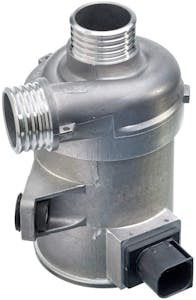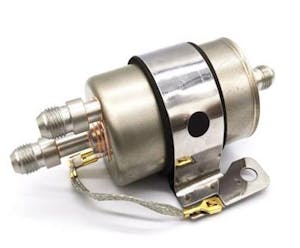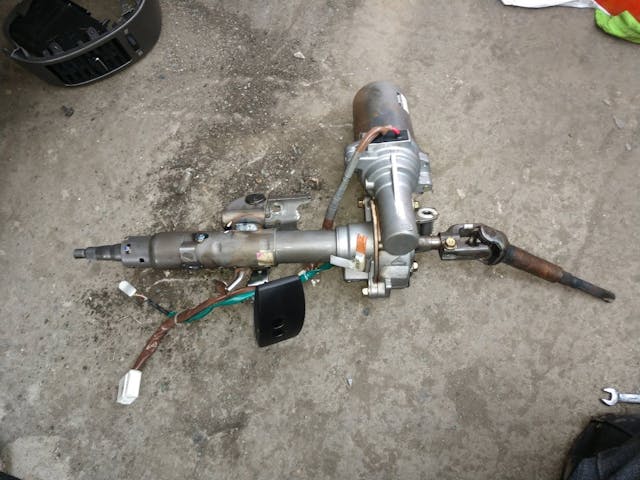4 high-tech, killer junkyard donor parts for your project
Known within the gearhead braintrust are a handful of off-the-shelf parts from production vehicles which serve as fantastic solutions for project cars. Examples include the mythical Ford Taurus fans, GM weather pack connectors and relays, rag joint-eliminating Jeep steering shafts, and the dozens of other well-known pieces. As cars have advanced over the past few years, especially with the move towards CAN-Bus integrated modules that can operate independently of their donor vehicle, an entirely new menu of indispensable OEM solutions has trickled down into junkyards and online suppliers. OEM-sourced parts tend to be well-engineered by suppliers who bank their revenue on providing reliable, long-life components for manufacturers, which brings down the cost of these mass-produced pieces for gearheads while also bolstering their durability. And unlike some aftermarket versions of these parts, these OEM pieces are occasionally available (affordably so) at your local parts store, making for practical road-side repairs.
Toyota EPS
Traditional power steering systems use hydraulic pressure to assist in turning the wheels via an engine-driven pump. Churning 1000 psi of power-assist draws on the engine’s total output, circulates a highly flammable fluid around a hot engine bay under great pressure, and requires several heavy components to complete the hydraulic circuit. Electric Power Steering (EPS) came about as a method to increase fuel economy by eliminating the typical hydraulic power steering pump for a beer-can-sized electric motor. EPS systems come in several variants, some of which only replace the engine-driven pump with an electric one while still retaining a hydraulic system as the source of power assist. The advantages here are considerable. EPS can free up room in an engine bay given the lack of need for a power steering pump, eliminate horsepower loss at the crank (as the system is only drawing when the steering system is loaded up, still creating less load via the alternator on the accessory drive than a hydraulic pump), and it remove a source of chaotic fluid fires. More info on the wiring and donor vehicles can be found here.
The system we’re keen on is the Toyota unit found in the company’s various compact cars over the past few decades. It houses the aforementioned beer-can-sized motor that drives the steering column directly through a worm gear, eliminating the need for any hydraulic power assist systems. The idea here is that the factory steering column is replaced by the Toyota EPS unit, while the steering box or rack itself is either swapped or converted to manual steering. There are a handful of donors for these EPS systems by various OEM systems; the GM unit found in the Delta-platform compacts (such as the Saturn Ion, Chevy Cobalt) is a popular one, but what separates the Toyota EPS is that it’ll operate with no modifications and nothing other than what you pull off the donor. That’s in contrast to the GM units requiring a signal generator, which can be found online but adds to the cost of the swap.
Pierburg CWA400/200 electric water pump

Electric water pumps arrived out of a similar quest for more efficient powertrains, divorcing their source of drive from the accessory belt. This change didn’t simply free up a bit of power and fuel economy, but gave powertrain boffins a way to slow down coolant flow when needed, which helps maintain ideal coolant temps in a broader range of conditions. For hot rodders, though, it represented a high-quality Lego brick that can easily repackage most cooling systems. It removed a load of bulk from the front of the engine, making room for superchargers and turbos of all sizes, and of course, drag racers will never be mad about a few extra horsepower.
The CWA400 and CWA200 are modular water pumps that need little more than an ECU-supplied PWM power source, which sets the pump’s rpm and can be provided by almost any aftermarket ECU. These are great for intercooler pumps too, and AN fittings aren’t too difficult to adapt to the inlet and outlet of the Pierburg pump. The key advantage (besides cost and OEM-grade quality) over the aftermarket electric water pumps that have been around forever is that these Pierburg units can be sourced through common storefronts, making replacements easy to find compared to catalog-ordered speed parts. Wiring connectors can be found here, and more info (including flow rate info) on the pumps is available here.
Bosch iBoost electric power brakes
Electronic power brakes hit the scene through more dramatic means. With the recent advent of EVs, without an internal combustion engine to act as the source of vacuum to provided power assist to factory brakes, such powertrains needed their own power brake solutions that no longer relied on vacuum to actuate. Of course, they have applications for traditional hot-rodders and project car wonks. Gnarly cams, custom-boosted applications, diesel swaps—each of these situations renders traditional vacuum-booster-assisted brakes either tricky or flat-out useless.
Tesla sourced iBooster electric power braking from Bosch simply because, well, it didn’t make sense to use an electric vacuum pump to pull on a typical booster. Skipping middleman and simply using an electric motor to provide the mechanical assist was far more sensible. Thankfully, the system can be easily retrofitted to a project, without any programming, using only three to four wires from the chassis for power, ground, and a switched ignition signal. The iBoost can be also be sourced from several other vehicles, avoiding the Tesla Tax that consumers often suffer through marketplaces such as eBay. Information on wiring plumbing the iBoost, and buying the appropriate connectors if you can’t get the pigtail with your donor brake booster, can be found here, here, and here.
C5 Corvette fuel regulator and filter

These are killer for EFI swaps because they solve a few issues in a compact package. In an EFI swap you’ll typically need to convert the fuel system to use a high-pressure fuel pump, which needs a regulator and return loop somewhere to bleed off excess fluid. The C5 fuel filter is a two-in-one unit that houses a 58-psi regulator with a return fitting, with only a single outlet running up to the fuel rail in a dead-head configuration. This simplifies the fuel circuit up to your fuel rails or throttle body injection unit, and it saves a bunch of space and cost by bringing the filter and regulator into a compact, commoditized unit. You can find kits with AN fitting adapters that slide over the GM quick-disconnects for well under a Benjamin, too.



Junkyards around here are chock full of Teslas and Corvettes. Sigh.